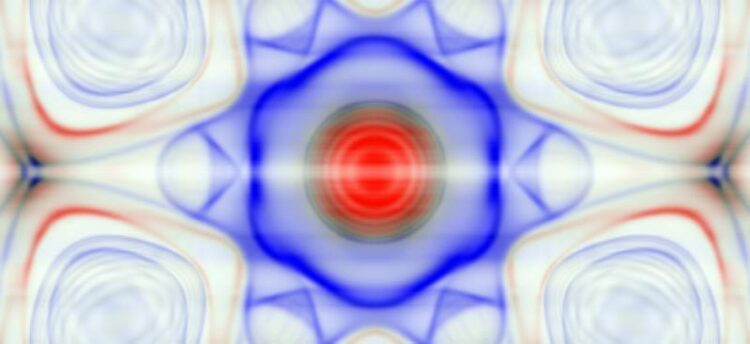Buckyballs on gold are less exotic than graphene

Using density functional theory and measurement data from spin-resolved photoemission, the team investigated the origin of the repeating Au(111) bands and resolved them as deep surface resonances. These resonances lead to an onion-like Fermi surface of Au(111).
Credit: HZB
Graphene consists of carbon atoms that crosslink in a plane to form a flat honeycomb structure. In addition to surprisingly high mechanical stability, the material has exciting electronic properties: The electrons behave like massless particles, which can be clearly demonstrated in spectrometric experiments. Measurements reveal a linear dependence of energy on momentum, namely the so-called Dirac cones – two lines that cross without a band gap – i.e. an energy difference between electrons in the conduction band and those in the valence bands.
Variants in graphene architecture
Artificial variants of graphene architecture are a hot topic in materials research right now. Instead of carbon atoms, quantum dots of silicon have been placed, ultracold atoms have been trapped in the honeycomb lattice with strong laser fields, or carbon monoxide molecules have been pushed into place on a copper surface piece by piece with a scanning tunneling microscope, where they could impart the characteristic graphene properties to the electrons of the copper.
Artificial graphene with buckyballs?
A recent study suggested that it is infinitely easier to make artificial graphene using C60 molecules called buckyballs. Only a uniform layer of these needs to be vapor-deposited onto gold for the gold electrons to take on the special graphene properties. Measurements of photoemission spectra appeared to show a kind of Dirac cone.
Analysis of band structures at BESSY II
“That would be really quite amazing,” says Dr. Andrei Varykhalov, of HZB, who heads a photoemission and scanning tunneling microscopy group. “Because the C60 molecule is absolutely nonpolar, it was hard for us to imagine how such molecules would exert a strong influence on the electrons in the gold.” So Varykhalov and his team launched a series of measurements to test this hypothesis.
In tricky and detailed analyses, the Berlin team was able to study C60 layers on gold over a much larger energy range and for different measurement parameters. They used angle-resolved ARPES spectroscopy at BESSY II, which enables particularly precise measurements, and also analysed electron spin for some measurements.
Normal behavior
“We see a parabolic relationship between momentum and energy in our measured data, so it’s a very normal behavior. These signals come from the electrons deep in the substrate (gold or copper) and not the layer, which could be affected by the buckyballs,” explains Dr. Maxim Krivenkov, lead author of the study. The team was also able to explain the linear measurement curves from the previous study. “These measurement curves merely mimic the Dirac cones; they are an artifact, so to speak, of a deflection of the photoelectrons as they leave the gold and pass through the C60 layer,” Varykhalov explains. Therefore, the buckyball layer on gold cannot be considered an artificial graphene.
Journal: Nanoscale
DOI: 10.1039/D1NR07981F
Method of Research: Experimental study
Subject of Research: Not applicable
Article Title: On the problem of Dirac cones in fullerenes on gold
Article Publication Date: 23-May-2022
COI Statement: none
All latest news from the category: Physics and Astronomy
This area deals with the fundamental laws and building blocks of nature and how they interact, the properties and the behavior of matter, and research into space and time and their structures.
innovations-report provides in-depth reports and articles on subjects such as astrophysics, laser technologies, nuclear, quantum, particle and solid-state physics, nanotechnologies, planetary research and findings (Mars, Venus) and developments related to the Hubble Telescope.
Newest articles

A universal framework for spatial biology
SpatialData is a freely accessible tool to unify and integrate data from different omics technologies accounting for spatial information, which can provide holistic insights into health and disease. Biological processes…

How complex biological processes arise
A $20 million grant from the U.S. National Science Foundation (NSF) will support the establishment and operation of the National Synthesis Center for Emergence in the Molecular and Cellular Sciences (NCEMS) at…

Airborne single-photon lidar system achieves high-resolution 3D imaging
Compact, low-power system opens doors for photon-efficient drone and satellite-based environmental monitoring and mapping. Researchers have developed a compact and lightweight single-photon airborne lidar system that can acquire high-resolution 3D…





















